Jason, 16, a gifted athlete and an accomplished youth basketball player scans the court. Three blue practice jerseys highlight his teammates. They are spaced about the half-court with the letters USA in white across their chests. Each talented. Each player is elite. Jason is playing with the best young basketball talent in the United States as a member of the USA Basketball Men’s Junior National Team.
The basketball, moist with perspiration, rests – held captive in Jason’s hands. Tanner, one of four defenders inches closer – crowding Jason. Tanner’s teammates, decked in white jerseys with USA letters in blue, align themselves to protect the basket. Sweat drips off Tanner onto Jason. Jason is unfazed, his body already covered by a stream of salty liquid. The air dampened by perspiration and exerted breathing, emits a stench unique to the arena of sport.
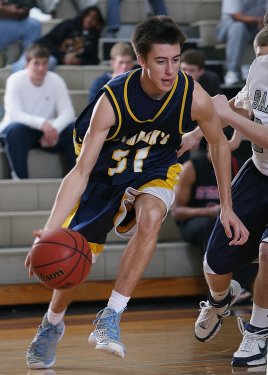
Image courtesy of Keith Johnston from Pixabay
Jason dips forward, swinging the ball from right to left across his chest to create some space from Tanner. Brett’s blue jersey appears to Jason’s left. Jason shifts, his upper torso leans to the left giving him an angle past his defender. His left arm extends as he pushes the ball through his fingertips. The ball darts soaring three feet above the court, landing in Brett’s hands. Brett, in robotic-like action, pivots, then squares his shoulders to the basket while slightly bending his knees.
On cue, Jason fakes to his right then following the direction of his pass slices left at a diagonal across the middle of the floor. White jerseys shift, adjusting to the ball and Jason’s movement. But the defender is beat. Brett, still squared towards the basket and in a ready position, snaps the ball to Jason leading him towards the basket. In one smooth motion, demonstrating his elite athletic ability, Jason snatches the ball with his right hand while exploding off his right foot. He floats the ball towards his left hand. The ball hovers motionless as Jason’s left-hand swoops in forming a cradle. The ball rolls from his palm through his fingertips towards the basket. The ball lightly touches the backboard, slips past the rim and brushes through the net. As Jason’s feet return to the court he turns, points towards Brett with his left hand and shouts, “Nice pass.”
Don Showalter, arms crossed, commands the action from center court. He remains stoic during the action, but starts back teaching after Jason’s bucket – shouting words of encouragement, correction, more encouragement and then direction to keep the action moving.
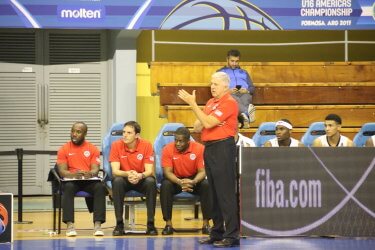
Image courtesy of USA Basketball
The practice session is one of 16 that Coach Showalter will conduct during a 9-day summer training camp prior to the Junior National Team’s departure for international competition. The Junior National team is selected from a pool of the top U16-U17 players in the United States. Today, elite players are invited to three, 3-day mini-camps in April, July, and October in addition to the summer training camp. During the summer camp the roster is whittled down to 12 for international competition. The Junior National Team competes in the International Basketball Federation (FIBA) qualifying tournament in odd years (e.g. 2017), and if they quality, the world championships the following year (e.g. 2018). Between 2009 and 2018, Showalter guided the U16-U17 Men’s Team for the United States. During that span the Junior National Team captured 10 gold medals and amassed a 62-0 record.
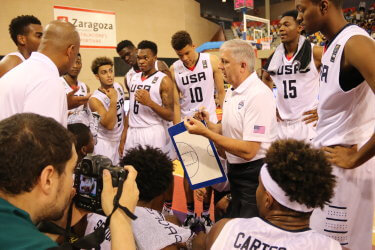
Image courtesy of USA Basketball
In the action described above, Jason and his teammates were participating in a drill called, Cutthroat. Cutthroat is a 4 on 4 live scrimmage situation Showalter uses to develop both offensive and defensive skills. The drill is governed by three basic rules: a) catch and square, b) move after a pass, and c) thank the passer when you score. Coaches may modify the rules to adapt Cutthroat to their coaching philosophy.
As the story goes, Cutthroat was created by Dick Motta as a method to teach defense. Motta started as a basketball coach in a small rural Idaho high school, where he led Grace High to a state title in 1959. He would eventually work his way to the National Basketball Association (NBA), where he won an NBA title in 1978 and would finished his career as the one of the all-time winningest coaches in NBA history [NBCA, 2018]. In the mid-1970’s Motta spent a few days teaching Cutthroat to aspiring basketball players at the Snow Valley Basketball School in Santa Barbara, California. The drill caught on and Cutthroat became a staple of the Snow Valley Camp, a camp that still operates today [US Sports Camps, 2019]. Coaches working Snow Valley, including Showalter, took the drill back to their own communities (For more on the Snow Valley Basketball School and Cutthroat visit: http://www.pheamerica.org/2019/snow-valley-a-learning-environment-for-coaches-part-iii/).
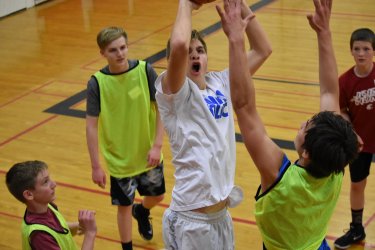
Image courtesy of Brooke Litalien
Showalter discovered that Cutthroat increased the intensity level of practice, helped build camaraderie, and that his athletes loved it. In working with the Junior National Team, Cutthroat proved to be a drill that helped elite athletes’ gel in a short period of time. But how Showalter uses Cutthroat demonstrates one of his key coaching lessons: It’s not what you teach – but how you teach it.
Cutthroat is a structured drill with set rules. A coach might implement Cutthroat in a practice session to improve the skills of their players (i.e. spacing, movement without the ball, etc.). In other words, Cutthroat is what the coach is going to teach. However, the success of Cutthroat in improving the skills of basketball players and building a team depends upon the coach taking sufficient time to prepare how they will teach it.

Image courtesy of Brooke Litalien
With the Junior National Team, the original guidelines of Cutthroat still apply (pass and cut, catch and square, and thank the passer), but Showalter adds additional rules to emphasize areas the team needs to improve on. For example, to improve ball movement on offense coaches might limit each player to two dribbles after they catch the ball and require the offensive team to pass the ball three times before they attempt to score. In this example, during the practice session Showalter teaches Cutthroat (the what) to communicate key areas (the how) needed to improve (i.e. better ball movement). In doing so he creates a learning environment that communicates his vision for helping the team reach their potential.
The concept of thinking about how you teach it, also applies to the pace or the flow of a practice session. In this instance, pace is the urgency with which athletes move between practice drills and how athletes are expected to perform at any given moment. Left to chance, athletes will often dictate the cadence of a practice session – a pace frequently short of the coach’s expectations.
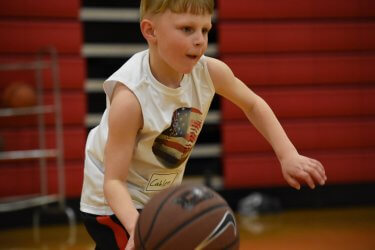
Image courtesy of Brooke Litalien
Setting the pace for a practice begins with first thinking about what you are going to teach. For example, in planning a two-hour practice session the coach may select instructional drills to work on individual skills, offensive sets for competition, and defensive tactics to stop the opponent. The pace is established by determining how the coach will teach each component relative to the purpose of the practice session. If the coach wants to have a high intensity practice, then the instructional drills might need to be modified to encourage active pace. If the coach recognizes the team needs more instruction in preparation for an upcoming opponent, instructional drills can be adjusted to emphasize key parts of the offensive or defensive strategy.
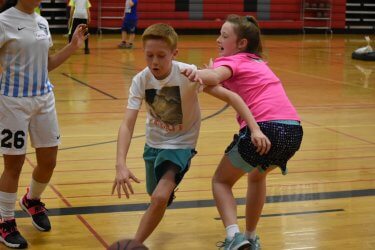
Image courtesy of Brooke Litalien
In summary, there are two reasons why a coach might want to focus on how they teach it. First, it will improve communication between coaches and their players and emphasize what is important to the coach. Second, by adapting the drills and training methods, athletes will develop skills relative to their role on the team. To implement this approach as a coach, apply the following four strategies:
Strategies to focus on how you teach it:
- Examine the instructional techniques you are currently using; Does this training approach develop the skills needed to help each player and the team grow in the manner you are seeking?
- Devote a certain amount of time each day for planning the time you spend with your team. Make a list of the activities that will be associated with that particular practice session. Then determine how you will communicate through the activities to move your team closer to your objectives.
- Organize activities for maximum efficiency by planning a pace that matches your purpose.
- Step back from time to time and reflect on the methods you are using. Ask yourself whether the methods you are employing are communicating to your players and team what is important to you as a coach?
*Pseudonyms are used for the names of the athletes represented in the article.
~Please post your thoughts and comments in the discussion section below this article~
References
NBCA (2018). Dick Motta consideration into Naismith Basketball Hall of Fame. Retrieved from: https://nbacoaches.com/dick-motta/
US Sports Camps (2019). Improve your game with the Snow Valley Basketball Schools. Retrieved from: https://www.snowvalleybasketball.com/
